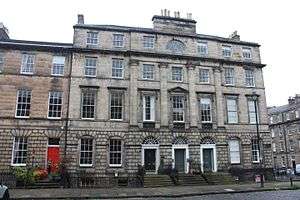Alexander Edington
Prof Alexander Edington MD CM FRSE (1860-1928) was a Scots-born bacteriologist and medical author strongly associated with South Africa. He made an important study of the Spanish flu pandemic of 1918.
Alexander Edington | |
|---|---|
| Born | 1860 |
| Died | 16 July 1928 (aged 67–68) Greytown, Natal |
Life

He was born in Edinburgh in 1860 and educated at George Watsons College before studying medicine at Edinburgh University. In the 1880s he became assistant surgeon to John Chiene and was then professor of comparative pathology at the Veterinary College in Edinburgh. In 1889 Edington was awarded a doctorate for his thesis, Contribution to surgical pathology and physiology.[1] In 1890 he is listed as living at 44 Great King Street[lower-alpha 1] in Edinburgh’s Second New Town, an impressive two storey corner flat at ground and garden levels within the corner pavilion.[2]
In 1891 he took a job as colonial bacteriologist and sailed to South Africa. This role appears to have been to gather data on the Rinderpest pandemic of 1890 onwards.[3][4][5] Edington's conclusion of his studies was to add glycerine to the animal bile, which had an immunisation effect. His views were controversial, some proved to be incorrect.[6] He also studied rabies in the Eastern Cape. [7]
From 1894 he served as Principal Medical Officer to the Cape Government.[8] In 1893 he was elected a fellow of the Royal Society of Edinburgh. His proposers were Alexander Crum Brown, John Chiene, Leonard Dobbin and Hugh Marshall.[9] He was president of the first medical congress in South Africa and editor of the South African Medical Journal. In 1900 he was awarded a doctorate for his thesis, South-African horse-sickness: its pathology and methods of protective inoculation.[10]
In both the First Boer War and the Second Boer War he both raised and served in the Ambulance Corps based at Grahamstown. He served with distinction in the First World War acting as officer commanding of the South Africa Military Hospital and Senior Medical Officer at Dar-es-Salaam. His official rank was Lt Colonel in the Royal Army Medical Corps. In the 1920s he was medical superintendent to Grey's Hospital (now part of Edendale Hospital) in Pietermaritzburg before going into private practice in Greytown.[8]
He died aged 68 in Greytown, KwaZulu-Natal on 16 July 1928 following a short illness.[11]
Publications
- Contribution to surgical pathology and physiology (Thesis). University of Edinburgh. 1889. hdl:1842/23872.CS1 maint: ref=harv (link)
- South-African horse-sickness: its pathology and methods of protective inoculation (Thesis). University of Edinburgh. 1900a. hdl:1842/23873.CS1 maint: ref=harv (link)
- South African Horse-sickness: Its Pathology and Methods of Protective Inoculation. Harrison and Sons. 1900b.CS1 maint: ref=harv (link)
- "South African Horse-Sickness: Its Pathology and Methods of Protective Inoculation". The Lancet. 156 (4031): 1568–1572. 1900c. Bibcode:1900RSPS...67..292E. doi:10.1016/s0140-6736(01)89022-x. hdl:1842/23873.CS1 maint: ref=harv (link)
- "Preliminary Note on the Occurrence of a New Variety of Trypanosomiasis on the Island of Zanzibar". Proceedings of the Royal Society of London. Series B, Containing Papers of a Biological Character. 80 (544): 545–549. 31 December 1908. Bibcode:1908RSPSB..80..545E. doi:10.1098/rspb.1908.0050. JSTOR 80284.CS1 maint: ref=harv (link)
- "Some Remarks on Spanish Influenza: Its Nature and Ætiology". The Lancet. 194 (5017): 730–731. 1919. doi:10.1016/s0140-6736(01)48855-6.CS1 maint: ref=harv (link)
References
- 44 Great King Street 55°57′28″N 3°12′00″W
- Edington 1889.
- Edinburgh and Leith Post Office Directory 1890-91
- Mack 1970, pp. 210–219.
- Burrows 1958.
- Miescher 2012, p. 28.
- Cranefield 2002, p. 300.
- Brown 2011, p. 134.
- "obituary Alexander Edington". Cambridge Journals. 1928.
- Biographical Index of Former Fellows of the Royal Society of Edinburgh 1783 – 2002 (PDF). The Royal Society of Edinburgh. July 2006. ISBN 0-902-198-84-X.
- Edington 1900a.
- Natal Witness. 20 July 1928. Missing or empty
|title=(help)
- Brown, Karen (25 April 2011). Mad Dogs and Meerkats: A History of Resurgent Rabies in Southern Africa. Ohio University Press. ISBN 978-0-8214-4367-5.CS1 maint: ref=harv (link)
- Burrows, Edmund H. (1958). A history of medicine in South Africa up to the end of the nineteenth century. A.A. Balkema.CS1 maint: ref=harv (link)
- Cranefield, Paul F. (2002). Science and Empire: East Coast Fever in Rhodesia and the Transvaal. Cambridge University Press. ISBN 978-0-521-52449-0.CS1 maint: ref=harv (link)
- Mack, Roy (1970). "The great African cattle plague epidemic of the 1890". Tropical Animal Health and Production. 2 (4): 210–219. doi:10.1007/bf02356441.CS1 maint: ref=harv (link)
- Miescher, G. (2012). Namibia's Red Line: The History of a Veterinary and Settlement Border. Palgrave Macmillan US. ISBN 978-1-137-11831-8.CS1 maint: ref=harv (link)
External links
- Biography of Alexander Edington at the S2A3 Biographical Database of Southern African Science